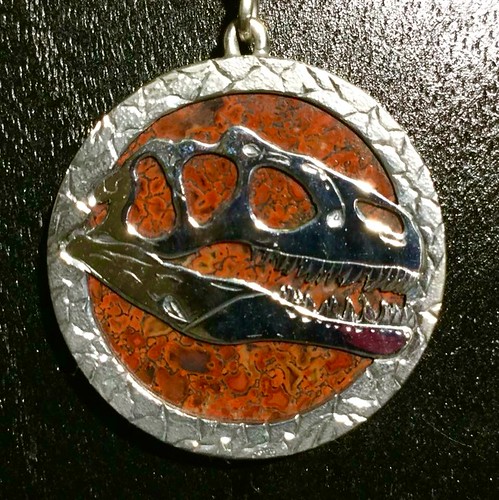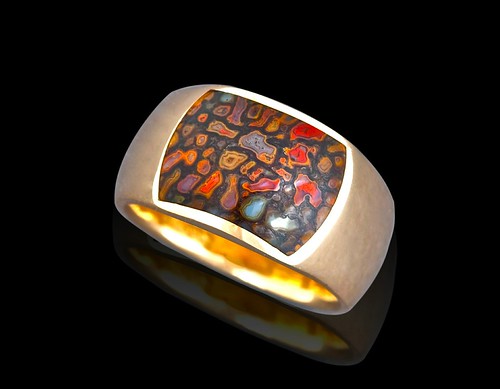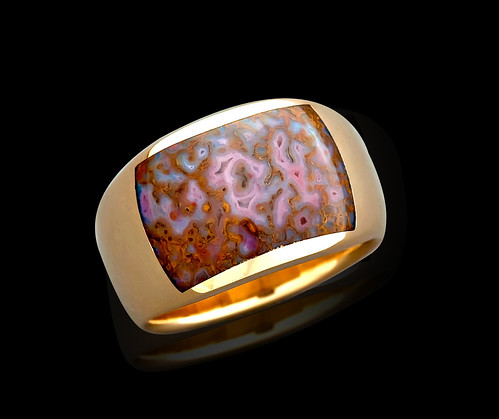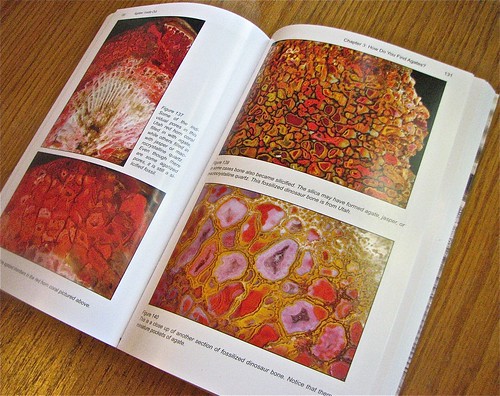Belt buckles with various color and patterns of gembone inlay, with hand engraved/sculpted Allosaurus skulls on top of rough gembone within the center of each piece. 100% hand fabricated by Mark Anderson of Different Seasons Jewelry.
High quality agatized dinosaur bone, or “gembone”, is one of my favorite gem choices for jewelry & lapidary art creations. Gembone specimens can be traced back to dinosaurs that roamed the earth during the late Jurassic Age around 150 million years ago. Gem quality petrified dinosaur bone specimens are among the rarest fossils in the world.. a true miracle of nature! Dinosaur bone is a gemstone with a magical allure, enduring and preserving a bit of our past, from the absolute mists of time, a stone that anyone with a sense of the fleeting nature of time should find attractive and magical.
Agatized fossilized dinosaur bones are petrified with silica or quartz crystals which gives them their colorful, glassy appearance. This process preserves the actual cell structure of the once living dinosaur. Non-gem grade fossilized dinosaur bones are found in many places around the world but the highly agatized and beautifully colored & patterned dinosaur bone known as “gem bone” is almost exclusively found in the four corners region of the Colorado Plateau in the USA (where the states of Arizona, New Mexico, Utah, and Colorado touch). I’ve shown various photos from our gembone collection to demonstrate the variety of cell structures and colors that can be found in higher quality agatized dinosaur bone. The wide variety of colors in agatized dino bone are caused by minerals such as chlorite, chromium, iron-oxide and manganese that enter the cells during formation.
This blog shows examples of my gembone jewelry and specimens.

Hand Fabricated 14k/18k palladium white gold ring and pendant set.
 18k Gold Gmebone Inlay Earrings
18k Gold Gmebone Inlay Earrings
14k high grade gembone inlay earrings, shown on the cover of Renee Newman’s Exotic Gemstones Volume 2.
Sterling Silver Gembone Inlay Necklace with a hand fabricated chain.
14K Gold Ring w/ Rare Pink Celled Gem Dinosaur Bone Inlay
Sterling Silver Ring w/ Blue-Red Gembone Inlay
David Greene Photography~
www.diaphoto.net/
Hand fabricated, sapphire capped 18k gold gembone inlay ring.
If you’re interested in having a custom gembone ring made please contact Mark at msadesigns@yahoo.com or Jessica at dow_jessica@yahoo.com
14K Gold Gembone Wedding Set
 Some of Mark’s first gembone inlay rings:)
Some of Mark’s first gembone inlay rings:)

Group shot of our gem dinosaur bone inlay Continuum silver pendants.
All pendants made with gem grade dinosaur bone, with the exception of the piece to the far right (made with Disdero agate).

Sterling Silver Ring and Pendant Set with Purple Gembone Inlay
Below show gembone specimens and slabbed gembone ready for lapidary work.
 Amazing top grade gembone slab
Amazing top grade gembone slab
Photography by Thomas Shearer
Peacock gembone vertebrae specimen in rare, vivid colors.
 Gembone vertebrae and a matching gembone inlay ring.
Gembone vertebrae and a matching gembone inlay ring.
Custom cast gembone inlay bolo ties. All wax models hand carved by Mark Anderson.
 Custom cast gembone inlay cufflinks
Custom cast gembone inlay cufflinks
Hand engraved, fabricated blue gembone inlay cufflinks.
22k gold reversible gembone earrings.
18k gold hand fabricated gem dinosaur bone ring.
Macro shots of various agatized dinosaur bone specimens~

All photos by Mark Anderson and Jessica Dow.
Interested in dinosaur bone and other exotic gemstones? Renee Newman’s book “Exotic Gemstones Vol 2” with a large amount of info on gem dinosaur bone is NOW available~
http://reneenewman.com/exotic2.htm
DIfferent Seasons Gembone rins featured in Rock & Gem magazine.
Different Seasons Jewelry Gembone Macro Shots for “Agates Inside Out” by Karen A Brzys
Photography by Thomas P. Shearer
For sale here~ www.agatelady.com/gift-shop.html
Here is some very interesting and informative reading about gem dinosaur bone written by my friend and fellow gembone collector Mark Buford.
“Dinosaur Gembone”~ by Mark Buford
The best dinosaur gembone is brightly colored and has very distinct cells surrounded by web like patterns. One of the prettier patterns exhibits black webbing, which provides very colorful cell definition. This webbing is one frequently found in high grade red and yellow gembone. There are many other colors of webbing including whites, blues, silvers, browns etc. One of the more fascinating cell-pattern combination’s are brightly colored pastel rich mosaics that mimic paintings. Vertebra when split correctly in half through the middle of the thickest cells make a pair of the prettiest display pieces you will ever likely see available. The best vertebra pairs to buy are the ones where the seller hasn’t cut slices from the middle so that you have the entire matched pair. These cost more and worth the price. Some other vertebra like neck or tail joints are only polished on one side and pretty as well. If you are fortunate you may even come across a vertebra with a spinal chord still intact.
Cells are vessels that are replaced by silicates and a mixture of minerals. Imagine no two cells are identical! Sometimes there are even whole blood vessels visible within a piece of gembone. Occasionally these are mineral filled and sometimes hollow. The very best gembone is colored crystalline quartz or agate. Less expensive gembone is plain colored, darker, fractured or sometimes soft. Some softer bone is beautiful. The hardest gembone is close to a hardness seven on Mohs scale. Rarely it is harder then seven. Other colored gembone that contain less silicate are typically less expensive. Ebay has some killer gembone at times, but these are uncommon and expensive. If it is beautiful, colorful and has large cells it’s probably worth the extra money. Weathered agate cells are frequently visible on the outside of gembone. These are not indicative of good or bad quality unless there is a new break or area showing the color and fresh surface of the interior. Freshly chipped or broken surfaces are like windows and can indicate the quality near the fracture. If it chips like flint it passes the hardness test. Cells are not always visible outside and rock hounds frequently chip a corner to closer examine the piece. Look for large cells because they can indicate potential and are desirable.
Calcite also replaces bone and is soft. Calcite produces some of the prettiest gembone and is frequently mixed together with agate; it is around a 5 to 6 on Mohs scale. This means it won’t polish as well or stay polished as long. Some spray laquer on calcite bone to make it shiny.
A variety of other minerals are found in gembone. Hematite and iron are common in gembone and will bleed red when polished. Some are pretty when polished and others not. Much looks burned outside in the rough and is considered lower quality bone. Occasionally iron pyrite or marcasite is found in gembone. Interesting that it is just this iron that gives us the prettiest reds and orange gembone. Sometimes the bone didn’t take just right when it formed. There are a number of other varieties of minerals and agates that replace bone including jaspers, and varieties of botryoidal agates. Rotted out bone centers frequently filled with crystal pockets. Quartz crystals and numerous other crystals have filled the centers of bones as well.
Always remember that gembone will vary in color from one end to end unless you see it has an extremely uniform nature. An odd thing about excellent quality bone, regardless of whether it is red, yellow, or even orange outside is, it is extremely unlikely the inside is the same color. Although red gembone is fairly predictable as red inside, it may have dead areas inside without cells. These dead areas are where the minerals that formed the gembone meet and look like meandering rivers across a nice background of cells otherwise. Frequently when gembone forms you end up with the finest on one end and the other end of far lesser quality. There is often a desert varnish around the outside. This varnish may be bright colored where the inside is not and vice versa.
Occasionally banded agate cells are formed in gembone under just the right conditions. Some of the prettiest looking are extra large ghostly cells of every imaginable shape and size. There are fortified cells full of crystal centers where some are banded or fortified, while others are patterned in wild fashions. Others are rounded in concentric like circles of differing colors. Others may contain miniature waterline agates within the cells. Rare gembone is multi-colored with multiple banded cells. Even better if there are multiple colored cells inside of cells scattered across an entire unfractured surface. These are the genuine stars of gembone! Banded cells come in all sizes from microscopic to enormous. When these combine with multi-colored bands scattered like stars surrounded by rainbows, you have found some of the worlds finest. Occasionally the inside of the cells will be filled with vibrant colors as well, where all one can do is appreciate the sheer beauty and say ooh or aah. Vertebras and large bone ends tend to have large cells and are a good place to seek these patterns.
Gembone comes in a multitude of colors with yellow and green being rarer colors. There is a color called candy-colored I believe that is the most uncommon which includes banded cells of every color including the yellows, greens, blues, oranges, reds, and many shades in between. It may be as rare or rarer then canary yellow. Blue gembone ranges in rarity from reasonable to extremely rare for baby blue which is seldom seen. Greens aren’t always rare as there are some very pretty colors of green and some less so. Many greens are softer bone and few are hard agate. The intensity of color applies to yellows as canary is quite valuable and mustard is less. A myriad of minerals add color to gembone. Irons added reds, browns, blacks, sulfur added yellows, copper caused greens and blues, manganese caused pinks and pastels, and the silica cause whites and grays.
Fortifications usually add value and eye appeal to gembone. These are agate patterns characterized by bands of color. Such banded agates are some what uncommon and some extremely unique. Often these fortifications are a crack or opening that are filled with colorful minerals surrounded by sometimes one or more bands of agate. Crystals of amethyst, citrine, calcite, etc are occasionally found at the center of these fortifications. Such fortifications range in size from microscopic to nearly the size of the entire piece of bone. Sometimes these take on incredible shapes and almost defy nature as to their complexity. Their formation was one where each layer was built before the next was started. A bone where the center has completely rotted out can fill with brilliant colorful fortifications when the conditions were just right and the gembone already began the preservation process.
There are a couple of different theories regarding the formation of gembone. I tend to adhere to two different theories. Consider the only bones likely to have turned into gembone were those quickly buried, otherwise they could have been eaten, crushed, or just eroded away. One theory is that gembone formed in a pressure or vacuum. It tends to reason since bones are made to transport blood, one might suspect minerals easily replaced empty cells and spaces. The most colorful only occured under certain circumstances when exposed to mineral rich baths. It is thought the water was much purer back then the water of today and was able to become far more saturated with silicates. These baths would drain or dry up over time due to weather and ground conditions; once again new minerals were introduced altering, adding, and evolving the process. This is one of the fascinating reasons for so many colors. Many times calcite would arrive and be deposited in the remaining voids. It’s common to see botryoidal and other agate pockets filled with calcite..
Hydrothermal activity is thought to have created gembone as well. During this process petrified bone was exposed to super heated gases or liquids. This activity carried minerals that replaced cells to varying degrees. Super heated fluids were essential in the creation of some of the finest gembone. Remember there was a great deal of volcanic activity during the time it was created. There is also a possibility of a large meteorite(s) causing incredible heat over vast areas where dinosaurs lived and died. Surely many times gembone was created and reformed this way; this explains some of the extended and twisted cell structures we find, some of which are discombobulated or nearly indistinguishable.
Ancient river beds, conglomerates, sedimentary deposits, and Morrison clays are where most gembone is formed. Today these ancient bone deposits have often eroded away carrying fragments down gullies, washes, and rivers for miles. Immense amounts of volcanic ash helped create Morrison formations which covered hundreds of square miles . Often ancient rivers swept dinosaurs downstream until jammed and locked up into river bends where they lay buried frozen in time. Consequently a great deal of gembone is found with river gravels and sediments attached.
Gembone is unique to the four corner region and Patagonia.
For more of Mark Buford’s writing on the subject of gembone~ http://search.reviews.ebay.com/members/mlbuford_W0QQuqtZg
{ 19 comments }
Jessa Dow
Latest posts by Jessa Dow (see all)
- Gem Dinosaur Bone~ Jewelry, Specimens and More by Different Seasons Jewelry - June 6, 2016
- Rare Gemstones by Renee Newman~ Contributions by Different Seasons Jewelry - February 9, 2012
- Renee Newman’s Exotic Gemstones Vol. 2 - January 30, 2011








































